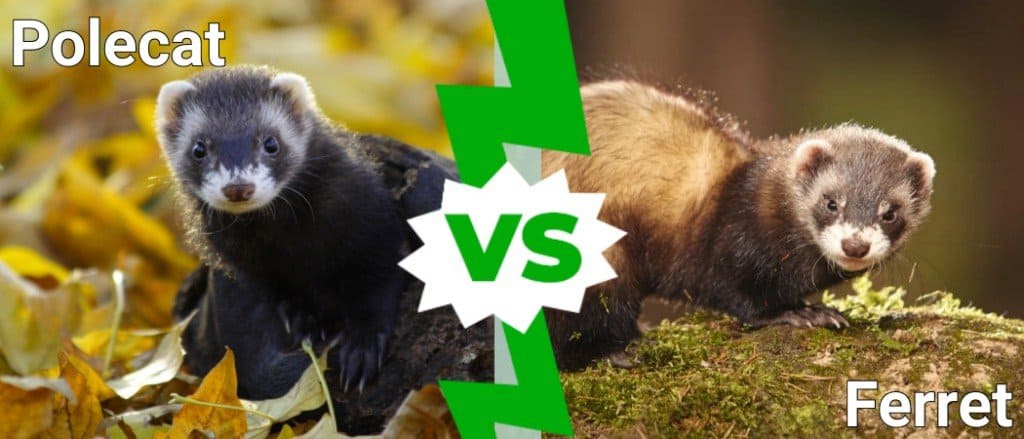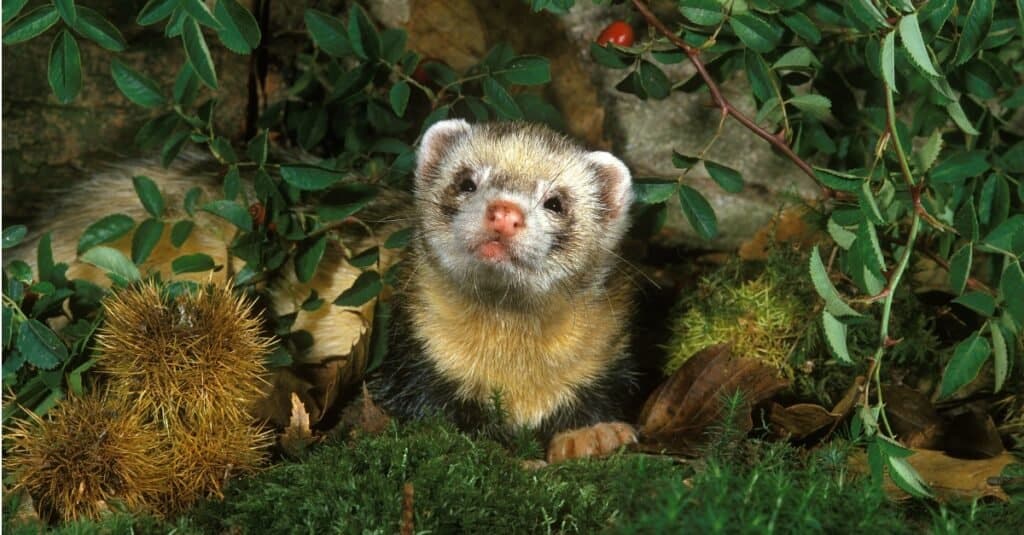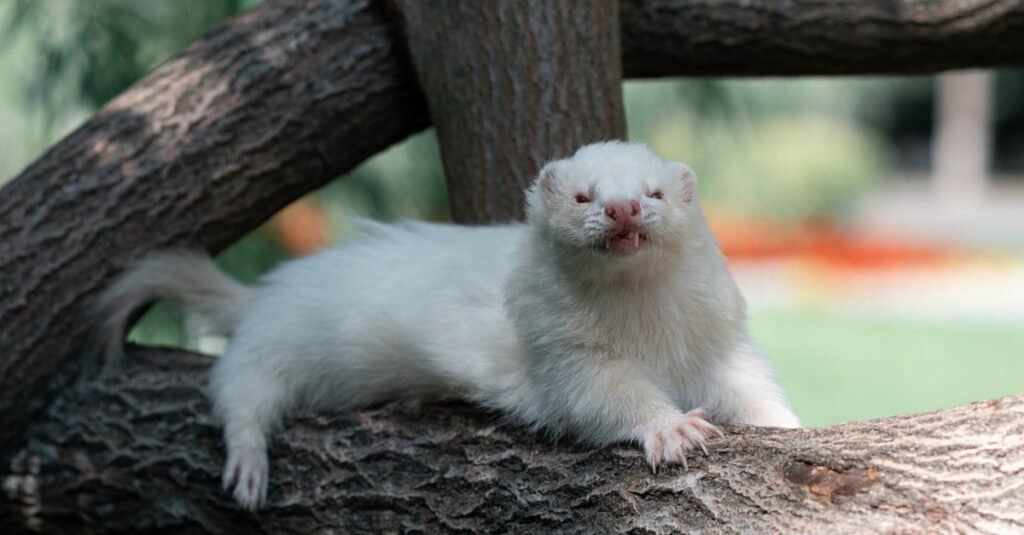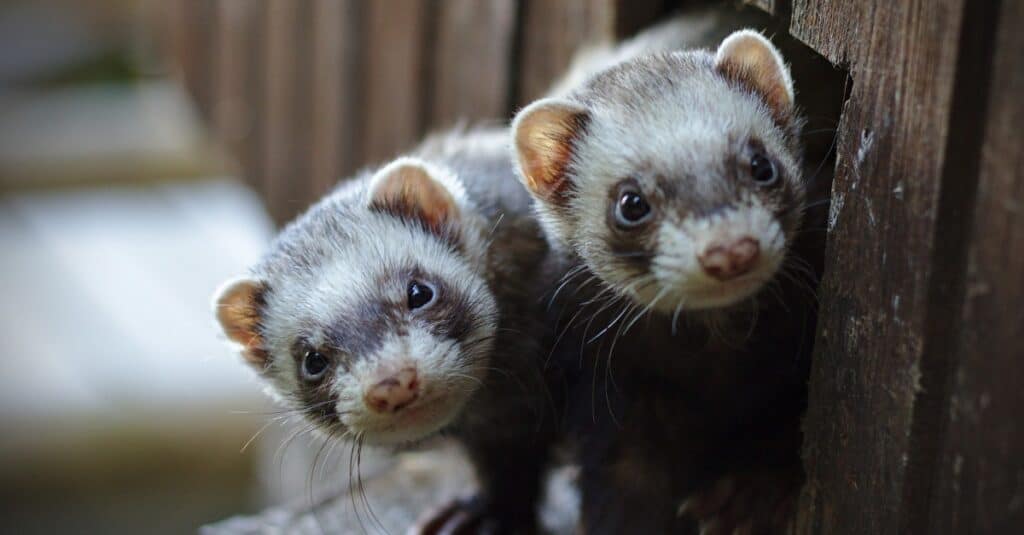When it comes to telling the difference between a polecat vs ferret, how can you learn how to tell them apart? While both of these animals are members of the weasel family, both polecats and ferrets have unique qualities that they don’t share with one another. But what might those qualities be?
In this article, we will address all of the differences between polecats and ferrets, including their appearances, preferred habitats, and dietary preferences. Not only will you be able to tell a ferret apart from a polecat- you’ll also know things they enjoy. Let’s get started!
Comparing Polecat vs Ferret

| Polecat | Ferret | |
| Size | 1-1.5 feet long; 2-3 pounds | 1-1.5 feet long; 2-3 pounds |
| Appearance | Large and strong body with larger head and ears; darker coloring and a stronger masked appearance | Slender and delicate body with small ears and face; found in a wide variety of colors including red, cream, white, and tan |
| Location and Habitat | Africa, Europe; found near water and grasslands or marshes | Europe and households worldwide; found in wild forests and farms |
| Behavior | Solitary creature except during mating season; non domesticated | Domesticated and enjoys social structures with both humans and other ferrets |
| Diet | Rodents, rabbits, fish, and lizards | Mice, rabbits, and gophers |
Key Differences Between Polecat vs Ferret

Ferrets enjoy social lifestyles, while polecats prefer a solitary existence.
©Couperfield/Shutterstock.com
There are many key differences between a polecat vs ferret. Polecats are more muscular than ferrets, though ferrets typically grow larger. You can also tell the difference between a ferret and a polecat based on their head sizes, as polecats have larger heads compared to ferrets. Finally, ferrets enjoy social lifestyles, while polecats prefer a solitary existence.
Let’s go over all of these differences in more detail now!
Polecat vs Ferret: Size and Weight

Polecats grow anywhere from 1-1.5 feet in length and reach 2-3 pounds, while ferrets grow 1-2 feet long and weigh 1-4 pounds.
©iStock.com/slowmotiongli
A subtle difference between the polecat and ferret is their size and weight. While polecats are more muscular than ferrets, the average ferret grows slightly larger than the average polecat. For example, polecats grow anywhere from 1-1.5 feet in length and reach 2-3 pounds, while ferrets grow 1-2 feet long and weigh 1-4 pounds. However, it depends on the domesticated status of the ferret, as some wild ferrets grow larger than others.
Despite their size differences, polecats are more muscular and stronger compared to ferrets. This is likely due to their domesticated vs wild natures, but it may also just depend on the particular polecat or ferret. These two animals are very similar, after all!
Polecat vs Ferret: Location and Habitat Preferences

While both of these weasels have darker coats in the summertime, ferrets are found in lighter shades compared to the dark fur of the polecat.
©Sergei Avdeev/Shutterstock.com
Another difference between a polecat vs ferret is their habitats and locations when found in the wild. While ferrets are domesticated, you can find both wild polecats and ferrets in a variety of locations. However, polecats are not domesticated, while ferrets are. You can find both ferrets and polecats throughout Europe, and many polecats exist in Africa as well.
Wild ferrets enjoy grassy or forested habitats, while polecats enjoy watery locations such as marshes or riverbanks. You are also more likely to find ferrets near developed areas such as suburbs or farms, while polecats prefer hunting in wild areas. But more on their dietary preferences later!
Polecat vs Ferret: Appearance

Wild ferrets enjoy grassy or forested habitats, while polecats enjoy watery locations such as marshes or riverbanks.
©iStock.com/CreativeNature_nl
There are a few subtle differences in the appearance of a polecat vs ferret. For example, ferrets are found in more color variations compared to polecats. While both of these weasels have darker coats in the summertime, ferrets are found in lighter shades compared to the dark fur of the polecat.
A polecat’s facial mask is much darker and more pronounced than that of a ferret, though both of these creatures are masked. You will also notice that a polecat’s ears are larger and lighter in color compared to the compact ears of a ferret. The chances of a ferret growing longer than a polecat are also high, though it is difficult to determine this unless you are looking at the two animals side by side.
Polecat vs Ferret: Behavior

A polecat’s facial mask is much darker and more pronounced than that of a ferret, though both of these creatures are masked.
©iStock.com/Harald Schmidt
The primary differences between polecats and ferrets are their individual behaviors. Whether a ferret is wild or domesticated, it prefers socializing far more than a polecat does. Polecats prefer to be left alone and on their own unless it is their mating season, while the same cannot be said for ferrets.
You have no doubt seen how social and entertaining domesticated ferrets can be when they play with humans and other ferrets. Polecats are not friendly animals, and this is partially due to their wild nature. However, they would likely remain antisocial if they were domesticated, given that they don’t spend time with their own kind in the wild. Ferrets enjoy the company of other ferrets, whether or not they are domesticated or wild.
Polecat vs Ferret: Diet and Hunting Style

Whether a ferret is wild or domesticated, it prefers socializing far more than a polecat does.
©iStock.com/Kyslynskyy
The final difference between a polecat vs ferret is their dietary needs and hunting abilities. While domesticated ferrets eat a variety of treats and ferret pellets, polecats are trained hunters. The jaw strength of a polecat outperforms the jaw strength of a ferret by a large margin.
Polecats eat rodents, rabbits, fish, and lizards, while wild ferrets eat rats, mice, and rabbits. Both of these weasels are carnivores, with polecats enjoying more aquatic meals compared to ferrets. Many wild ferrets also seek out food from developed areas such as farms or barns, while polecats avoid the potential for human interaction whenever possible.
The photo featured at the top of this post is © Denis Kukareko/Shutterstock.com
Thank you for reading! Have some feedback for us? Contact the AZ Animals editorial team.






